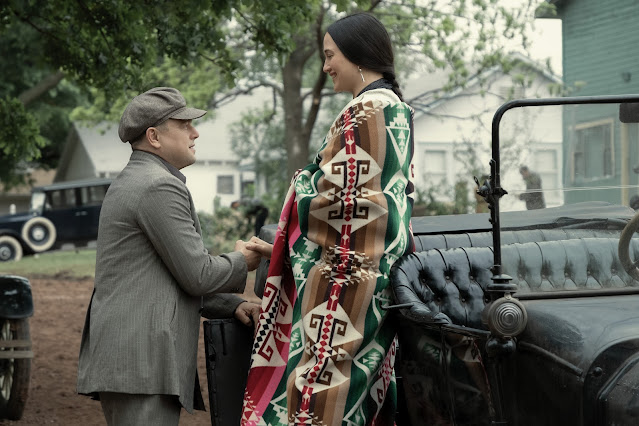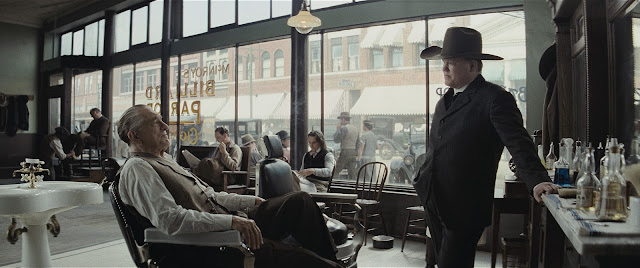- Get link
- X
- Other Apps
- Get link
- X
- Other Apps
 |
| Leonardo DiCaprio as ERNEST; Lily Gladstone as MOLLIE in KILLERS OF THE FLOWER MOON |
"Can you find the wolves in this picture?"
In Killers of the Flower Moon, Ernest Burkhart (Leonardo DiCaprio) reads these words aloud from a book his uncle has given him about the Osage people. They become a prophecy and an indictment of what is to come for the viewer and Ernest. We will meet many proverbial wolves in sheep's clothing in the hours to come, but Ernest himself is both sheep and wolf – a true unreliable narrator. This simple-seeming bit of line reading offers a lens that will keep viewers guessing where Ernest's true motivations lie long after the credits roll.
Martin Scorsese throws all of his weight in adapting David Grann's immensely popular true crime book, Killers of the Flower Moon. This type of story fits nicely into the director's wheelhouse: communities in tumult, rampant crime, morally ambiguous characters, and power struggles. The book chronicles the time period known as The Reign of Terror in the 1920s. The Osage people, flush with wealth from the reserves of oil on their land, become targets for violence and victims of unsolved murders. J. Edgar Hoover commissions the FBI to handle the case.
 |
| JaNae Collins as RETA, Lily Gladstone as MOLLIE, Cara Jade Myers as ANNA, Jillian Dion as MINNIE in KILLERS OF THE FLOWER MOON |
While Grann spends most of his page count on the efforts of Tom White to bring the criminals to justice, Scorsese and screenwriting partner Eric Roth choose to focus more on married couple Ernest (DiCaprio) and Mollie Burkhart (Lily Gladstone), two of many characters in the book. Ernest has come home from the war and goes to work for his uncle, William Hale (Robert DeNiro). Hale convinces Ernest to court and wed Mollie, waxing eloquent on how God intends the Osage wealth to really belong to the chosen white people. So we see the Osage murders exemplified through Mollie's experience of having her entire family exterminated, one by one. In press notes, Scorsese calls this their love story, although that's a generous reading. Ernest believes he loves his wife, but his love co-exists with being complicit in his uncle's schemes to wipe out the entire tribe. Such love looks more like exploitation, however unintentional.
While Scorsese might proclaim the story centers the "love story" between Ernest and Mollie, in truth, the narrative primarily follows Ernest. The camera loves Mollie and admires her, but we see the world through Ernest's eyes, for better or worse. He becomes the conduit through which we view Mollie. Mollie's character starts out strong, but she becomes a victim and a side character, even leaving the story entirely for most of the final third of the movie. Her true feelings and thoughts after Ernest's arrest remain a mystery.
To be fair, Scorsese takes great pains to represent the Osage people well. Scorsese and Roth interject plentiful Osage language into the dialogue with no subtitles. The Osage people speak and act gracefully and with dignity. Costume designer Jacqueline West dresses the community in eye-pleasing authentic clothing. But mostly Scorsese represents the Osage through the person of Mollie, and her presence is greatly missed once she leaves the movie in the final third.
 |
| Lily Gladstone as MOLLIE, Robert DeNiro as WILLIAM HALE, Leonardo DiCaprio as ERNEST in KILLERS OF THE FLOWER MOON |
Scorsese and the casting directors chose her well. She carries the communal heartbreak of an entire nation on her face but somehow manages to exude an air of calm and strength at all times. The other Osage characters appear briefly, as snapshots of a whole. They all suffer from a debilitating sickness that comes from the forced assimilation into white culture. Whether the disease manifests as melancholia, diabetes, alcoholism, violent outbursts, or sexually promiscuous behavior, the Osage have a collective illness. And Lily Gladstone skillfully manages to express that illness in her performance.
As Ernest, Leonardo DiCaprio pulls off his most internally conflicted character ever. He seems to have no moral compass of his own. Just point him in a direction, and he will keep going like the Energizer Bunny. He seems tormented to witness his wife's suffering, yet he continues to act in a way that will lead to that outcome. He swears that he loves his wife, but are these feelings part of the performance his uncle has manipulated him to give? And has he given that performance so well that he's even convinced himself? Mollie calls him the coyote – the trickster. When the two of them share the screen, sparks fly and questions arise. Mollie seems way too wise to fall for someone like Ernest. But she comes to love the trickster and believes in his integrity past the point of incredulity. In turn, he wants to be the man she believes him to be. Their romance is by far the main point of speculation in the film.
Scorsese manages to keep the generous runtime from feeling arduous through pacing and wise editing, at least until that final third. Killers of the Flower Moon walks the line between the frenetic energy of Goodfellas/The Departed and the contemplative meditation of Silence. This rotation of energy that works well in keeping the plot from dragging. For example, at the beginning, the Osage people go through a ceremony where they grieve the loss of their culture. Immediately after, a scrapbook of images depict the Osage becoming wealthy. This cheerful success story then cuts to the bleak image of a dead Osage man lying on his back, mouth foaming.
 |
| Robert DeNiro as WILLIAM HALE, Jesse Plemons as TOM WHITE in KILLERS OF THE FLOWER MOON |
Character building and interpersonal dynamics take center stage, interspersed with bursts of violence. For the most part, murders and acts of violence occur with a sense of detachment, echoing how Hale and his drones felt about disposing of Osage people. To Hale, they were game pieces on a Monopoly board, unworthy of an honorable death. The notable exceptions are the deaths of Reta (Janae Collins) and Bill Smith (Jason Isbell), whose home is bombed. As the house burns, Ernest looks out the window, watching men try to put out the firestorm, their bodies outlined by the wall of orange flames. The distant images appear as in a haze. Cinematographer Rodrigo Prieto shoots this section like a dream. The choice highlights that being his uncle's puppet is beginning to take a mental toll on Ernest.
The final third shifts to a police procedural and courtroom drama as Tom White (Jesse Plemons) investigates the murders and finally brings the culprits to justice. This section is the point where viewers may struggle to keep attention – not because of the content itself. Everyone loves a good law and order story. But the Osage people are left behind, and attention shifts almost fully to Ernest. When Mollie comes back, we are practically gasping for air in relief.
Luckily Scorsese wisely ends the story on a whimsical yet poignant note. Performers (including Larry Fassenden) come on stage and enact the story as a radio drama, with sound effects and a live audience. People may argue about what this means. I choose to believe the director means to highlight the way that Indigenous stories have been whitewashed for entertainment. Scorsese hopes that his film can be a part of correcting that, even if his story still ultimately centers one of the murderers and not the Osage people he hopes to honor. Perhaps an Osage filmmaker will tell the story one day. And perhaps stories about Indigenous people won't always have to be narratives of suffering.
"Can you find the wolves in this picture?" Yes, we can.
Release info: In theaters October 20, 2023
Final score: 4 out of 5
Lindsey Dunn is a film critic with membership in both NC Film Critics and Southeastern Film Critics. She loves all things Cobra Kai, Netflix Dark, indie horror, and any stories about complicated relationships. You can find her at 1ofmystories.com and most social channels @1ofmystories.
- Get link
- X
- Other Apps
Comments